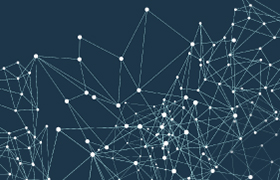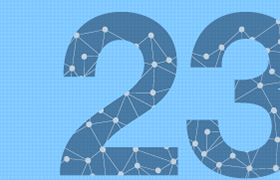23 Reasons to Get Excited About Data
Table of contents
Key points
-
Introduction
Introduction
These days, everyone’s tossing around the term “big data.” The term is nothing new—businesses have been collecting and analyzing data since the 1950s, before the two words were ever even uttered. Take a look back in time and you’re likely to see someone laboriously poring over a sheaf of spreadsheets, manually going through row after row to identify trends and gain insights. It’s a job Bob Cratchit would probably have turned down.
But the spreadsheet approach was reliable in that it could impact future decision-making. Data has always had value to businesses because they can use the information and associated analysis to increase operational efficiency, reduce costs and serve their customers. Today, however, instead of manually processing data, data analysis technology makes it possible to make immediate decisions, giving companies a leg up on their competition.
Now, can you possibly contain your excitement about data?!!
Of course you can. Because data isn’t exactly something that lights your fire unless you can visualize how it can make your life better. And it can, with the right application. Data is exciting when it’s your business partner, a personal friend, a difference maker in the world or a buddy you can lean on.
-
The latest trends
The latest trends
More people are doing more things—personally and professionally—with data, and best practices will continue to develop. Self-serve data analysis and easy analytics tools are on the rise and over time they will only:
- Get bigger: Access to big data will be readily available to help us give context to decision-making. We’ll be extracting value from everything data-ish, so look beyond your computer, smartphone and tablet. Look near, at your watch, fitness tracker and other wearables. Look far, to that oil rig in the Gulf and satellite in space.
- Get faster: Users will demand speed, which will require technologies to keep up. Data analytics technologies will offer expansion options to give speed to existing solutions. We’ve come to expect instant gratification, so we can make immediate decisions.
- Get cloudier: Big data has already combined with the cloud and the data warehouse will eventually meet its end game. Data analytics technology will increasingly move towards on-demand, cloud-based warehousing.
Still not jumping up and down about data? Here are 23 reasons why you should change your tune.
-
Section 1: Power your business
Section 1: Power your business
1. Increase sales and future opportunities.
Data in the sales environment is based on the assumption that past activity can predict a prospect’s behavior, specifically by using past purchases and preferences. You can look at what a customer bought and when, so you can forecast when they’ll buy again. Plus, you can use these details to determine whether it’s appropriate to offer complementary products. Some key demographics to review are:
- Online sales: Shoppers often browse through your offerings and place items in the basket—only to leave them there because they’re not ready to buy. You can study this data to re-target those shoppers with additional marketing messages or deals based on what’s in their cart.
- In-store purchases: Creating a customer loyalty program is an excellent way to understand buyer behavior. Collect data such as purchases, anniversaries, wish lists and other details to help you plan marketing efforts.
2. Collect more payments on time.
When you let accounts receivable go longer than payment terms, you’re essentially extending credit to a vendor. Data can help you avoid the situation and reduce the need to take collection action. Here are just two of many examples:
- Billing and invoicing: Data can trigger notifications from your accounting system, informing you that a bill needs to go out, or has gone out and not been paid. It also helps lessen the impact of human error when using manual processes for sending out invoices.
- Contracts: Collecting details on the companies you do business with can also tell you when your sales people are overriding invoice terms, which is helpful for keeping tabs on contracts that deviate from standard policies. This data can also be used to assist you with creating new contractual terms in your invoices. For example, if credit terms are overridden often, it may be time to change them.
3. Make your products and services better.
You can use data to understand the reactions of customers to your products and services, which positions you to better understand what they want from you—and what potential customers will expect. Common customer actions include:
- Product returns: A high number of product returns causes customer trust and confidence to slide.
- Emails: Open rate, click-through rate and conversion data can help you improve your email marketing campaigns.
- Delivery: Use data based on when and how fast your products got to customers to make adjustments to your processes or shippers.
What’s in this data can show you patterns of success you can apply more often or to other areas. Or, you might see a need for an overhaul to improve your product lines, services or policies. With your data, you can set thresholds that will issue notifications when customers take these actions—and you can respond accordingly.
You can use data to understand the reactions of customers to your products and services, which positions you to better understand what they want.
4. Become a market savvy expert who’s ready to find new markets.
It’s difficult to look at an overview of your existing market and determine where to expand into new markets without data. There are four types of data analytics that can tell you more about the current landscape and help you find new spaces.
- Customer analytics: Analytics can tell you a lot about your customers. You can see the age groups that are active in your market or one you might want to enter. Gender, average income, family size, internet usage and other data are helpful as well.
- Website analytics: Key figures coming through your website metrics include visitor location, language, search terms and referring sites. There might also be more direct interaction, such as who is making inquiries, making purchases and reviewing products. Analytics enables you to make sense of these different metrics.
- Marketing analytics: Chances are you use a combination of website, blog, social media profiles and other internet marketing combined with print, radio and TV advertising. When analytics are applied to the data extracted from these efforts, you get insight about where you might consider looking for new markets.
- Social media analytics: Trends, engagement and interactions on social media provide considerable data regarding emerging markets. Data analytics tools deliver insight you need to be part of the conversations your customers are having online.

Jessie Liu @jessiecliu
Today, retailers are constantly finding out innovative ways to draw insights from their data—both online and offline—to better serve their customers and increase sales. In fact, big data analytics is applied at every stage of the retail process: from identifying the right customers, optimizing pricing for a competitive edge, and predicting trends, to forecasting demands. Big retailers have been reaping the benefits of their data for years, but only recently did they start to get a grip on how to use unstructured data like social media posts, customer comments, pictures, phone conversations, and location data. Small businesses can also benefit from the same data even if they cannot afford to implement expensive data collection infrastructure and hire data scientists. A growing number of software companies such as IBM are providing big data and analytics as a service to small businesses.
5. Streamline processes for maximized operations.
Making your business run more smoothly and improving productivity require you to eliminate those processes that are clogging efficiency. Data supports the analysis by answering a number of questions:
- What happened or is happening? Here, data offers insight on each phase of your workflow process, identifying and reporting on events.
- Why did it happen? Diagnosis of weaknesses or errors is easier when you look at the data that surrounds and supports the events.
- What will happen due to the event? Data helps you forecast a multitude of circumstances based on an event, ranging from the best possible result to the worst-case scenario.
- What is the desired outcome? From the best possible result, you can work backwards using data to identify what’s happening that’s holding your processes back.
6. Get your business running like a well-oiled machine.
There are a number of ways you can improve your business beyond processes and operations. But do you know what they are or where they can be found? Data helps you identify those policies, products, services, and other offerings where your business isn’t delivering the best possible results. There are three primary areas where you’ll see benefits:
- Costs: You’ve probably gotten so used to shoveling out money for certain costs that you’ve never even considered the opportunities to reduce that spend. A good look at your data can tell you where waste or inefficiency should be addressed.
- Resources: If you’re not using your available resources efficiently and effectively, you’re leaving money on the table. Waste and inefficiencies abound in certain processes, but you’ll never know unless you review your data.
- Employees: Data you collect from your team can yield useful information about current employees, your recruiting process and employee retention. This is especially important considering that your team is among your most valuable assets, representing a significant investment.
There are a number of ways you can improve your business beyond processes and operations.
7. Offer customers what you know they’re looking for.
Data is especially useful at drilling down into the demographics of your customer base. Details like their age, income, living environment, household buying habits, average spend on certain goods, job position and other information can help you separate them into segments for marketing purposes. You understand the importance of knowing your audience and engaging them with marketing messages, so it’s clear the same tactics won’t work for all of your customer segments. You’re better able to target the right message to the right group when you have data to tell you about their preferences and habits.
8. Attract, win and retain more customers.
Customers love loyalty programs. They can earn points or rewards on future purchases, get extra bonuses on birthdays or anniversaries, or receive targeted information on discounts. But your business can also benefit, because you can use and apply the data gathered by a loyalty program. The numbers tell you what products customers prefer, what deals they’re seeking, how much they’re willing to spend and how they’re using the benefits you extend. Armed with that information, you can find new customers with offers that have proven to work and keep loyal customers with personalized service.
9. Share stories and make points when visualized.
Have you ever looked at a bunch of numbers that report on a certain phenomenon or topic…but they really seem to mean nothing? Now think about how these figures could be valuable if they’re put in graph, chart or infographic form. All of a sudden, you can tell a story that gives meaning to the numbers behind the phenomenon. You can see that web traffic is up and bounce rate is down—all because you made a few adjustments to your home page.
Or maybe you want to demonstrate how your solution can help a customer solve a complicated problem. You can’t make the sale by reciting a bunch of numbers that you’ve collected. Visual representations of data are ideal for bringing content to life in creative ways you never imagined.
10. Get on top of those KPIs.
Depending on your business, you’re always looking at multiple KPIs to measure performance. But what indicators require daily monitoring, a weekly look or monthly analysis? Which KPIs mandate your full, immediate attention…and which ones need just a tweak? The data you collect assists you with categorizing those gauges you simply cannot ignore, separating them from the indicators that don’t require constant monitoring.
-
Section 2: Make a personal impact
Section 2: Make a personal impact
11. Foster your curiosity as a “citizen analyst.”
Data can tell us a lot about the world we live in. But even just five years ago, the technology required to analyze it was out of reach for the average Joe. Fast forward to now, where the majority of us have access to enterprise-level analytics for a song. Combining data with analytics tools allows us all to be citizen analysts that download huge amounts of data, crunch the numbers and discover the deep stories that lie beneath the surface.
12. Become an artist or storyteller.
We’ve all got great stories, but data helps us tell them better. How can you talk about the “zombie apocalypse” without referring to the droves of people that became “undead” over just a few months? Can you really tell another person about how you lost weight through walking unless you show them your FitBit data? Is it possible to convince others that you’ve found the perfect match on Match.com without showing the data that illustrates your compatibility?
Data adds credibility to your story, which makes you a better storyteller. But it doesn’t end there—data can make you an artist, even if you never pick up a paintbrush or mold clay. Effective data visualization increases reach and comprehension, making complex or obscure topics more accessible to others. The key is taking mathematical details and transitioning them into a work of art or a story.
13. Be a better you.
Are you trying to get into shape? Do you want to know more about your sleeping patterns so you can get better rest at night? Data can help you become a better you as it’s collected on one of the sleek fitness tracker devices, like FitBit, JawBone UP4, Microsoft Band 2, Garmin Vivofit or any number of other wearable brands. Even smartwatches can help you live a healthier lifestyle with tracking applications and pedometer tools.
While the specifics vary by brand and model, fitness trackers count the steps you take, the number of stair flights you climb and other activities. Many will monitor your heart rate, so you can tell your level of activity during the day. Some wearable devices track your movements while sleeping, so you know when you were restless and when you were deep in a great REM cycle. And even better, these fitness trackers sync with your smartphone, so you can monitor your activity levels over time. This information can help you improve your health as you constantly strive to beat your daily or personal bests.
A fun story for lawyers and enthusiasts of the legal process: Fitness tracker data has even been used in courtroom proceedings by the McLeod Law Firm in Calgary, Canada. An accident victim needed to prove that her levels of activity were greatly diminished after the incident, which would impact her quality of life—and, more importantly, her jury verdict amount. So maybe that’s not fun if you’re the defendant, but still…
Data can help you become a better you.

Christopher Penn @cspenn
If you recall in the early days of social media and content marketing, much was made of the rise of the citizen journalist, the independent participants who report alongside traditional media. We don’t hear much about this trend anymore because the smartphone turned everyone into a citizen journalist the moment they opened the camera app. Citizen journalism isn’t a trend any longer; it’s now the default.
The rise of the citizen analyst potentially could follow a similar trajectory. Five years ago, doing heavy statistical analysis required the use of SPSS and probably one or more serious database servers. In the enterprise, these would cost hundreds of thousands of dollars to build and deploy.
Fast forward to today, where we have access to enterprise-grade analytics for nearly nothing. Basically, you can cheaply obtain the same kind of computing power that enterprises forked out six figures for not too long ago.
The democratization of these tools means that the rise of the citizen analyst is a reality. Citizens can download large public datasets from Data.gov and similar services, then crunch their own numbers and find out the deeper story behind numbers they see in the news or in their workplaces.
14. Determine your career path.
Sites like Monster, CareerBuilder and LinkedIn are go-to resources for job seekers at various stages of their careers—from right out of college, to making a switch, to finding a company they’ll retire with. But these sites are typically more advantageous for recruiters looking to match resumes and skills with job descriptions.
In the not-so-distant future, it will be possible for job hunters to input their own data, including skills and experience, of course. But there will also be strategies for providing intangible “soft skills” that employers crave. You’ll be more in control of your career path because you’re matching both professional and personal traits—so you’re more likely to find happiness and job satisfaction.
15. Climb the career ladder.
Data can reveal the secrets of getting to the top in the corporate world as well. There are lots of seminars, books, presentations and other sources where you can learn about leadership skills. But data can tell us so much more about the common characteristics of great business leaders, such as their educational background, degree and first job post-graduate. You’d probably be surprised to learn that the CEOs of many top corporations didn’t go to Harvard or Yale; the head of Cisco went to Gonzaga, while Signature Financial’s top dog graduated with a degree in political science.
What does this data mean for your career? The playing field is wide open and there are multiple paths to the top. Spend time in different areas of the business instead of being an expert in just one function. And as it relates to some specific careers, data can be very useful:
- Sales and marketing: Data extracted from the five W’s and H of journalism can help you identify and target customers more effectively:
- Who is your audience?
- What are their interests, needs and goals?
- Where do they live, work, play, and hang out online?
- When will they be making purchasing decisions?
- Why do they need your company’s offerings?
- How do your customers like to consume information about your products?
- Human resources: HR departments and recruiters rely on data to fit the right candidate with the right position. By looking at key data fields, they can filter down a handful of qualified job seekers from thousands. HR pros take details like education, work experience, location and other demographics to make their job easier. Data can even tell you which employees are outperforming others, which ones might be ready for advancement planning—and even those team members most likely to steal.
- Data analysis: Why not climb the corporate ladder by looking into a career in data? Big data is big. Harvard Business Review calls data science the “sexiest” job of the 21st century and it’s showing huge promise for those looking to switch careers or get started with a rewarding position. You could be the one assessing the 2.5 petabytes (yes, that’s 1,000 terabytes) of data collected from Walmart’s 1 million sales transactions per hour. Fan of video? Maybe you’d prefer to analyze the more than 48 hours of content uploaded to YouTube every minute globally.
16. Forge more and better relationships.
It’s not such a stretch to discover that something seemingly impersonal as data can actually help improve our personal relationships. Here is how.
- Dating platforms: You know these applications and there’s a good chance you’ve used them to meet potential partners. And you can certainly see how data weighs into presenting suitable candidates that users are likely to be compatible with. Data is not going to match you up with a heavy metal lover if you’re into classical music, and it won’t connect a gluten-free enthusiast with a bakery owner.
- Social groups: Much like data can align you with the ideal date, it can be used to put you in touch with people who share your interests. Personal relationships are forged through common denominators and data helps you identify those individuals that you’d like to spend time with.
- Entertainment: How often do you watch a video on YouTube or Vimeo simply because one of your social media connections gave it a thumbs up? Do you ever listen to Spotify tunes based upon the listening habits of others? Entertainment preferences are nothing more than data collected and analyzed to present you with choices that you’re likely to love.
We’re all active players in the game, collecting, interpreting and forming opinions about data. We’re not just passive collectors; we use data to better connect with the people in our lives.
- Sales and marketing: Data extracted from the five W’s and H of journalism can help you identify and target customers more effectively:
-
Section 3: Make a difference to others
Section 3: Make a difference to others
17. Do good in the world.
Data makes the world a better place for us now and future generations in the years to come.
- Tracking abandoned properties: Old, decrepit buildings are an eyesore and dangerous to those who encounter them. That run-down two story brownstone with the rickety porch looks like a playground to children seeking adventure. Many municipalities use data to track abandoned properties and secure them to prevent accidents.
- Public transportation: Your rush-hour commute is made more tolerable with analytics that tell public transportation strategists how to schedule subways, buses and commuter rail lines. Data is the reason you have six express trains leaving between 7–8AM, and only one or two from 10AM until 4PM.
- Bike and ride share programs: First introduced in major cities, bike and ride sharing programs get you where you need to be—with less of a carbon footprint and harmful emissions. Data is used to plan placement and scheduling of vehicles, ensure they’re in the right spot where and when you need them.
- Crime forecasting: Neighborhood Watch programs make your community safer and they facilitate relationships between neighbors and law enforcement. Data lends a hand by providing forecasting on the types and times of criminal activity, so neighbors know to keep an eye out and police have your back.

Bob Hayes @bobehayes
Data from your loyalty programs can be put to good use in your customer experience management (CEM) program. The primary goal of a CEM program is to optimize customer loyalty by improving the customer experience. To that end, CEM programs often rely solely on self-reported measures of customer loyalty (e.g., surveys ask customers about their expected behaviors) as the ultimate criterion by which to determine which customer touch point has the strongest link to customer loyalty. With the use of your loyalty program data, you know precisely what your customers are buying and to whom they are recommending your brand.
By marrying both attitudinal data and behavioral data in their analytics, companies can now get a more accurate picture of the factors that are responsible for improving real loyalty behaviors.
As businesses integrate data silos, they are able to ask and answer bigger business questions.
Experts Predict: Analytics Trends (@OrgNet and @cspenn)
Learn more about how Watson Analytics influencers Emilio Ferrara (@jabawack), Bob Hayes (@bobehayes) and John Cook (@JohnDCook) answer the question: What trends in data analysis are you seeing today, and what are the opportunities for the future?
18. Change preconceived notions.
We approach each day with certain expectations about how things will happen, which has an impact on our perceptions of the world around us. The problem is that our own senses trick us into negative bias unless we examine, question and drop preconceived notions that hold us back. That scruffy looking man on the park bench is a company CEO and philanthropist, but the well-dressed woman on the elevator is being investigated for corporate fraud.
Data gives a neutral, comprehensive picture of certain situations, so we’re not limited by partiality. Data sheds new light at times where bias would otherwise takeover, like:
- The Know-it-all: Been there, done that. The Know-it-all forms conclusions based on previous experiences which may not even be relevant.
- The Victim: This person got burned in the past and is determined to never get stuck in that position again, despite all signs pointing to different conclusions.
- The Professor: If the Professor reads it, it must be true—never mind the fact that he or she is simply extracting information without context to draw conclusions.
- The DIY’er: This independent spirit sees everything as a task they can totally do without professional help—or maybe with just a little guidance.
Data is the great equalizer in kicking these personalities and their preconceived notions to the curb. It reveals the meaning behind the numbers and opens your eyes to new experiences and impressions you might have otherwise been blind to.
19. Change healthcare.
Is there a better way to make a difference for others than by improving healthcare? Data has changed the way we handle healthcare and approach treatment.
- Prevention of diseases: Curing an ailment is hands-down more expensive and traumatic than preventing disease in the first place. Data collected from thousands of other patients can be used to identify in others the red flags often associated with certain conditions. Healthcare professionals look at data from an array of sources (insurance records, genetic demographics—even the wearables mentioned earlier) to develop a patient-specific picture that helps people live longer, with better quality of life.
- Development of treatments: Your physician doesn’t pick a diagnosis and treatment out of a jar. The prescription you receive is the end result of countless data compiled from other patients with similar conditions who were given treatments in clinical trials.
- Prevention of epidemics: The “zombie apocalypse” may be preventable by looking at data, as it’s already helped fight the spread of disease in Africa. Mobile phone GPS technology has proven useful in tracking population movements, which assist healthcare professionals and government agencies in predicting Ebola virus infection. Data tells us where treatment centers should be positioned and where travel restrictions should be implemented, if necessary. Here’s what William McKnight, President of Knight Consulting Group, says: “Data not only tells us how epidemics are spreading; it also tells us where to put sensors to detect contamination detection. Accidental or malicious introduction of a contaminant into resource distribution systems could potentially have severe health effects on a population, as well as social and economic impacts."
- Quicker access to the right doctor: William McKnight says, "We have all had the experience of having to wait some time to get certain treatments. This is often the case of there simply being a backlog to services. Better access (or perhaps collaboration of data) would expedite treatment options."
20. Study the complications of diseases.
Disease outbreaks impact the entire globe and it’s not just a human health crisis: Epidemics carry a hefty price tag, as the affected West African countries have invested $32.6 billion to fight the spread of the Ebola virus. The World Bank has also committed $400 million to the cause. How can data help us reduce the human and economic impact of deadly diseases?
HealthMap.org is a platform that takes data from public health, media and other sources to deliver real-time news and alerts about outbreaks. The site detected the early warning signs of the Ebola epidemic a full nine days before the World Health Organization made it front page news. Co-founders Clark Freifeld and John Brownstein (developer and epidemiologist, respectively) recognized the need to organize and structure the huge amount of outbreak-related data available online. Without structure, data does nothing to help decision making—especially when time is of the essence.
The platform consists of a web crawler that continuously scans the Internet and collects data from thousands of channels, including the media, health organizations and government agencies. With filtering technology, HealthMap can pinpoint threats down to the specific location.
-
Section 4: What else can you do with data? Things you probably never thought of
Section 4: What else can you do with data? Things you probably never thought of
21. Get better at predicting game outcomes.
Ask any fan of any sports team, “Who will win the big game?” Most will say their favorite team is going to hoist the victory torch, no matter how lopsided the stats or score. The problem is that so many fans are driven by emotions when it comes to predicting game outcomes—not facts. Through the use of data, numberFire is changing the game.
It’s one of a few applications that combine analytics with algorithms to convert misleading unstructured data into predictions about game outcomes. As a company, numberFire submitted a bracket to the 2012 March Madness tournament and not only correctly predicted the winner (Kentucky), but also placed in the top 1% of all submissions. With data, you improve your betting odds. So lesson learned: Show you’re the biggest fan by painting your face, NOT by placing your bets based on emotion.

Anil Batra @AnilBatra
You should be asking: “Why am I in business, what do I want to do, how can I create a better customer experience, how can I drive my customers to do what they are here to do and what do I want from my business?”
That’s when you start to define what should be measured, what KPI should be there. So you have to look at what you are doing as a business then figure out what you should be measuring.
Look at what you are doing as a business then figure out what you should be measuring.
Experts Predict: Analytics Trends (@debbiebere, @rtkrum and @AnilBatra)
Learn how Watson Analytics influencers Deborah Berebichez (@debbiebere), Randy Krum ( @rtkrum) and Anil Batra (@AnilBatra) answer the question: If you had to make a prediction, which trend do you think will have the most significant impact on the future of Analytics and why?
Experts Share: Data Tips (@debbiebere, @milesaustin, @JuntaeDeLane, @AnilBatra and @tonyadam)
Watson Analytics Influencers Deborah Berebichez (@debbiebere), Miles Austin (@milesaustin), Juntae DeLane (@JuntaeDeLane), Anil Batra (@AnilBatra) and Tony Adam (@tonyadam) answer the question: What is your #1 tip for anyone who is asked to use data to inform business decisions?
22. Dominate your fantasy sports leagues.
Predicting the winner and loser of a game is just the start for data’s role in sports. NumberFire also takes your fantasy sports teams to the next level in merging algorithms with numbers. The app boasts that its use of data delivers a 31% higher chance of winning fantasy leagues across all professional sports and outdoes expert projections a whopping 93% of the time.
Sports data gaming is just starting to hit its stride.
Sports data gaming is just starting to hit its stride, though the demand for analytics in fantasy leagues has existed for a while. It’s only logical that data would find its way into this realm eventually; stockbrokers and traders have been using complex models and trading algorithms for decades. NumberFire’s founder and CEO, Nik Bonaddio, likens sports data to finance: Games are all about the numbers—box scores, running vs. passing yardage, batting averages and free throw percentages. It’s not such a stretch to take data to sports.
23. Improve your microbrewing.
It’s the end of the list and time to celebrate! Luckily, data can help us with that, too. What started as a hobby turned into a profitable startup for Jason Cohen, who developed the program Gastrograph to help microbreweries—and himself—create a better product. As a craft beer aficionado, Cohen was frustrated when his batches didn’t always turn out to his liking; as a data scientist, he knew there must be a way to collect data and use it to improve his home brews.
Gastrograph can pinpoint flaws in the brewing process or ingredients with just a handful of tastings, so there’s no need to get tipsy trying to improve your batch. The program works by identifying 24 different taste attributes common to different beer styles. A user downloads the app and creates a profile based upon the 24 flavors. Data captured by Gastrograph is submitted to a data center, where artificial intelligence and algorithms “learn” about preferences. Once the data is crunched, it’s available to a user on a dashboard, where common flaws are revealed. For instance, a flavor profile that’s akin to fresh-cut grass has too much of a certain compound—which arises when the hops are stale.
-
IBM Watson Analytics has your back
IBM Watson Analytics has your back
And you didn’t think there were great reasons to get excited about data. Now that your eyes are opened and you can see all that it can do, the opportunities are limitless—right? Not so much…
It’s one thing to collect data; it’s quite another to get meaning from it. Data needs context to give the numbers cognitive capabilities. You need to identify trends and gain insight to make it worth collecting. Data talks, but you need a microphone to hear what it’s saying. So, back to the spreadsheet approach, right?
Thanks to Watson Analytics, there’s no need for manual review of the boatloads of data you’re trying to make sense of.
What is Watson Analytics? Self-serve, easy access, guided analytics. IBM launched Watson Analytics with a goal to deliver advanced analytics functionality without the complexity of other kludgy solutions. Unlock the value of the data you’ve gone to great lengths to collect—or take advantage of external data sources you didn’t even know existed. Interact with data conversationally, and with reason and purpose, to get answers and insights that can take your business to new heights:
- Natural language query enables you to explore your data and find new associations and insights in plain language.
- Compelling visualizations are automatically created just for you in one click to help you make sense of data and tell more powerful stories.
- Predictive analytics automatically surface the factors behind your outcomes.
- Data refinement cleanses, shapes, converts and combines data from multiple files and formats to make your data stories more meaningful and relevant.
- Expert Storybooks help you learn, understand and evaluate data in ways you never thought possible. Our expert storytellers bring you into the experience, so you can gain the most relevant data to explore patterns and relationships.
- Watson Analytics for Social Media (add-on) analyzes social media data to offer more than simple listening. Take the pulse of your audience to better understand their needs and apply what you’ve learned to your business data analysis.
- Various versions to suit your needs: What will you do with Watson Analytics? No matter what type of usage, the analytics tools will suit your needs.
- FREE: Use it for free and get access to cognitive, predictive and visual analytics.
- PLUS: All the functionality of the free version, plus access to larger data sets and storage capabilities.
- PROFESSIONAL: The enterprise level edition takes the Free and Plus tools, with the ability to add more users for collaboration efforts and more data connectors.
Get answers, gain insights and make confident, educated decisions within minutes.
Next Steps

Try Watson Analytics for free
Analyze your data easily and on your own without downloading software.

Download the eBook
Read the entire PDF featuring additional insights from our Watson Analytics Predictioneers.

Follow the conversation
Visit the IBM Watson Analytics blog to keep up with the latest trends.

Take a Tour of Watson Analytics
Attend a Watson Analytics webinar to see first hand what easy analytics can do for you.